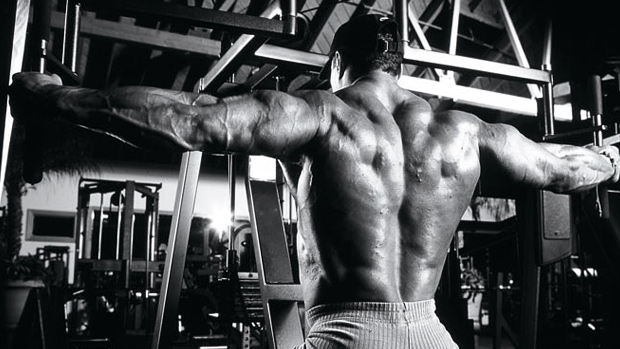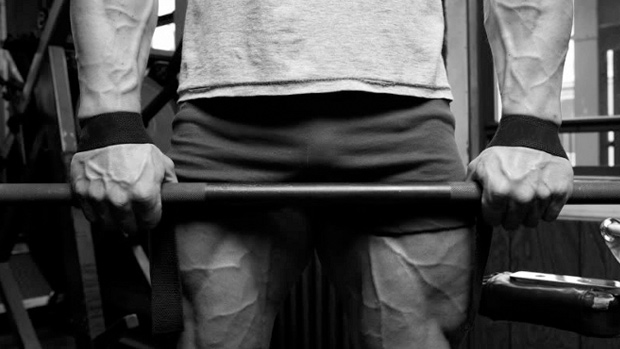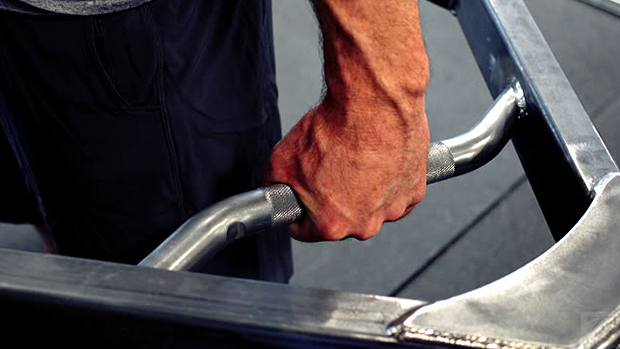I bet we all see things in the gym that really, really, annoy us. There's the "belter," the guy who sports his trusty lifting belt for every exercise, including kickbacks with pink dumbbells and marathon sessions on the hip adductor machine. Then there's the guy who mindlessly bangs out fifteen sets of biceps curls in the power rack as you impatiently wait to do squats. And we certainly can't forget the "Third Musketeer," the geek who takes 45 minutes to do three sets of bench presses because he insists on reading the newspaper and sharing recipes with friends in between sets.
You get my point. Sometimes people in commercial gyms simply drive us nuts! And while idiotic gym behaviors definitely get on my nerves, they're far cries from my greatest pet peeve: individuals who constantly grumble about rotator cuff pain.
Why do their complaints aggravate me so much? Well, the sad truth is the vast majority of them have no idea what the rotator cuff is or what it does! Let's put an end to this unfortunate trend right now. I'll also show you how to reap the benefits of direct rotator cuff training!
Shoulder Anatomy
The term "shoulder" is actually best used to describe a complex or region which consists of roughly twenty muscles and five articulations (1). Nonetheless, the term "shoulder joint" is often used to refer to the glenohumeral joint, the articulation between the humerus (upper arm) and glenoid fossa (cavity) of the scapula. Although the remaining four articulations all play integral roles in upper body motion, the glenohumeral joint is of foremost importance to our discussion.
The glenohumeral joint is designed for maximum mobility to allow the broad spectrum of upper body movements to occur. Unfortunately, this mobility comes at the expense of stability. In fact, this joint is often compared to a golf ball resting on a tee, as the surface area of the humeral head is three to four times that of the glenoid cavity. Without the glenoid labrum–a fibrocartilage ring around the fossa–this cavity would be even more dangerously shallow (2).
Besides the shallow depth of the cavity, glenohumeral instability may also emerge due to laxity in the supporting ligaments and weaknesses in the surrounding musculature (3). With such a great potential for instability, it's no wonder the bones and soft tissues of the shoulder region are some of the most often injured parts of the body. Luckily, specific rotator cuff training can dramatically increase the joint's stability.

Manual of Structural Kinesiology
Rotator Cuff 101
The muscles of the rotator cuff are easily remembered by the acronym SITS: supraspinatus, infraspinatus, teres minor, and subscapularis. All of these muscles originate on different portions of the scapula and insert on the humeral head where they converge at the glenohumeral joint capsule to form a tendinous cuff around the joint (4).
Collectively, they assume the crucial role of stabilizing the humeral head within the glenoid cavity. Beyond stabilization, each of the muscles also individually contributes to humeral motion:
- The supraspinatus originates on the upper border of the scapula and inserts on the humeral head (3). It assists the deltoid in abduction (raising the arm to the side, as in a lateral raise) of the humerus (especially the first 15° of motion), although the muscle is capable of abducting the humerus without the deltoid's assistance (4). The supraspinatus is of particular importance in preventing subluxation during overhead motions such as throwing, tennis serves, military presses, lateral raises, and pointing out spandex-clad goddesses doing stiff-legged deadlifts to your buddies. It's the most commonly injured rotator cuff muscle (3).
- The infraspinatus has points of attachment on the posterior scapula and humeral head. The muscle contributes to several humeral motions, including external rotation (think of "rolling" the biceps away from the body, as in a tennis backhand), horizontal abduction (as in a posterior delt fly), and extension (as in a chin-up) (3).
- The teres minor originates just below the infraspinatus on the posterior scapular surface and inserts on the humeral head. The muscle contributes to several humeral motions, including external rotation, horizontal abduction, and extension. Along with the infraspinatus, it maintains posterior stability at the glenohumeral joint (3).
- The subscapularis is the only one of the rotator cuff muscles originating on the anterior surface of the scapula, and is thus hidden behind the rib cage and several larger muscles. With its insertion on the humeral head, it acts on the humerus through internal rotation, adduction (bringing the arm toward the body, as in a cable crossover), extension, and stabilization (especially at the anterior and lower aspects of the glenoid cavity) (3). The subscapularis receives quite a bit of work with the high volume of internal rotator work (pecs, lats, anterior delts, and teres major) in most training programs; therefore, since most gym rats are bench-happy, direct subscapularis training isn't necessary unless a specific strength deficit is present.

Right Shoulder, Posterior View. Source: Sports Injury Management: 2nd Edition
Why Train the Rotator Cuff?
Most of you have probably never heard of these muscles before, so it's likely you're wondering why you should bother training them. Here's why:
Strength: Let's put it this way: if you have the stabilizers of a Girl Scout, do you think you're going to be able to handle manly loads on your mass building exercises? Personally, I'd much rather be pressing a Buick than pushing boxes of cookies!
Weak external rotators of the humerus are limiting factors to development of internal rotator size and strength, as the body won't allow progress to continue in the presence of an imbalance which could lead to injury. We all know the pecs, lats, and delts have outstanding growth potential, but few recognize that this potential can't be fully realized unless the external rotators are up to par.
It's not uncommon to see an individual break through a bench, row, pull-up, or Olympic lift sticking point just by incorporating direct external rotator training. Likewise, a little attention to supraspinatus training can yield equally favorable results in overhead pressing and lateral raise strength.
Safety: The rotator cuff is of paramount importance in injury prevention. Internal rotator dominance is extremely common among bodybuilders, powerlifters, and athletes for whom the pecs and lats are prime movers. These imbalances are also omnipresent in swimming, baseball, volleyball, and tennis due to the high volume of overhead motions (2, 3).
Strengthening the rotator cuff and the resulting improvements in glenohumeral stability significantly decreases the occurrences of humeral head subluxations, dislocations, and nagging overuse shoulder injuries. It goes without saying that injuries are one of the greatest barriers to progress in the gym. If you're in too much pain to lift weights to stimulate growth, you won't be doing any growing!
By giving the muscles of your rotator cuff the attention they deserve, you can eliminate the loss of valuable training time to injuries and increase your training longevity.
Size: In addition to all the indirect ways that direct rotator cuff training can lead to size, let's not forget the four muscles of rotator cuff themselves are capable of hypertrophy!
Unfortunately, hypertrophy in the subscapularis and supraspinatus is unlikely to be noticeable due to their positions behind the rib cage and deep to the upper trap, respectively. Growth of the infraspinatus and teres minor, on the other hand, will certainly further one's back development by enhancing the "V-frame."
When an individual is quite lean and possesses good external rotator development, the separations between the posterior deltoid, infraspinatus, teres minor, teres major, and lats are readily apparent and quite impressive, especially during the back-double biceps pose.
Posture: Several factors can lead to tight internal rotators. Many athletes and lifters who utilize these muscles extensively without attention to the external rotators can experience a marked shortening effect of the internal rotators due to tightness (2,5). One mustn't look any further than the countless fitness enthusiasts who display rounded shoulders for evidence of this trend.
This shortening effect is also noticeable in individuals who spend considerable amounts of time hunched over a desk or simply exemplifying poor posture. Over time, poor posture can place considerable stress on the skeletal and nervous systems, leading to injuries and decreased performance in the gym. A combination of internal rotator stretching and external rotator strengthening has proven successful in decreasing the anterior inclination of the thoracic spine (6).
Improved Range of Motion on Mass Builders: Simply stated, exercises performed through complete ranges of motion yield superior gains in muscle mass; otherwise, the guy doing quarter squats and cheat curls all the time would be the biggest one in the gym! If your internal rotators are tight, your ROM and potential for mass development will be greatly diminished.
Confidence: Some might debate me on the psychological carryover of a physiological change, but I'm a firm believer that you'll have a lot more confidence supporting big weights if you know your stabilizers are healthy and strong.
You wouldn't want to get under a squatting bar unless your core and lower leg muscles were comfortable supporting the load on your shoulders; the same is true of benching, chinning, and overhead pressing. Confidence is an often-overlooked component of strength training performance, even if it's only confidence that your humeral head is going to do what it's supposed to do during your set.
The Plan
The following is a comprehensive program which hits the muscles of the rotator cuff from a variety of angles. It should be performed in place of your shoulder routine, preferably at the end of a chest training session.
Since the rotator cuff is of paramount importance in stabilizing the glenohumeral joint during your heavy presses, we don't want to pre-fatigue it and risk injury. Allow at least a day of rest after this session before you do any more upper body work.
- A. Barbell Cuban Press (also known as the muscle snatch):
- Sets: 3
- Reps: 6-8
- Tempo: 4020
- Rest Interval: 60 seconds, during which you should stretch the pecs, lats, and anterior deltoids.
- B. L-Lateral Raise
- Sets: 1
- Reps: 8-10
- Tempo: 3020
Note: This exercise should be performed immediately after the last set of Cuban presses only. Rest 60 seconds after the set and then proceed to C1.
- C1Side Lying Dumbbell Abduction to 45°
- Sets: 2
- Reps: 10-12
- Tempo: 3022
Note: Start with your non-dominant arm. Without resting, proceed immediately to C2 with the same arm.
- C2Low Pulley External Rotation
- Sets: 2
- Reps: 10-12
- Tempo: 3022
Note: Without resting, return to C1 and repeat superset with the other arm.
Exercise Descriptions
Cuban Press: Grasp a barbell and perform a wide-grip upright row until the bar is about two inches below your clavicle. Once the bar reaches this level, hold the elbows steady while externally rotating the bar as if you were trying to touch it to your forehead. As the external rotation phase completes, press the bar overhead.
Lower the weight along the same path and repeat for reps. This exercise preferentially recruits the infraspinatus over the teres minor, and there's certainly significant contribution from the delts and traps as with any upright row or press. Be forewarned that the Cuban press isn't an ego booster; the external rotation phase is a limitation to moving big weights with the movement.



L-Lateral Raise: To finish off the infraspinatus, hold a dumbbell in each hand and perform a lateral raise to 90° with the elbows simultaneously flexed to 90°. Once your upper arms are parallel to the floor, externally rotate your humerus so that your forearms are perpendicular to the floor (as in the mid-phase of a military press).
Side Lying Dumbbell Abduction to 45°: Think of this as a single-arm, half-lateral raise while lying on your side. The two-second pause at the end of the concentric (lifting) portion of the movement really intensifies the exercise. For some individuals, performing this exercise on a flat bench may feel awkward; a low incline is an acceptable alternative.
MRI muscle activity tests have shown that this form of abduction elicits significant contribution from all of the rotator cuff muscles except the teres minor (7). Recall that the deltoid doesn't become an effective abductor of the humerus until the arm reaches the 15° point, so the supraspinatus bears the brunt of the load, especially because upper trap involvement is minimized (4).

Low Pulley External Rotation: Set the handle on a low pulley at slightly above knee height and stand with your non-working side toward the weight stack. Grasp the handle with your working arm and pull it across your body until it's at upper thigh level on the opposite side. This is the starting position. The elbow should be flexed to approximately 90° with the upper arm held as close to the body side as possible.
To execute the concentric portion of the movement, externally rotate the humerus (all the motion should be at the shoulder) while simultaneously trying to keep the elbow close to the starting position (some movement will occur) in order to preferentially recruit the teres minor. After holding for a two-count at peak contraction, slowly reverse the movement and repeat for reps.

Additional Notes
- Make sure you keep your wrist firm throughout all of the movements.
- Proper posture is also critical to executing these exercises correctly. Think about keeping your chest pushed high and out while looking straight ahead.
- Although the posterior head of the deltoid (another external rotator of the humerus) is indirectly worked in this program, you should devote two or three sets to bent-over lateral raises or seated rope rows to the neck on your back day to give this head the attention it deserves.
- On days you aren't performing this program, I recommend performing high rep external rotations with surgical tubing or a stretch band, as per Chad Waterbury's article, 100 Reps to Bigger Muscles.
Throughout the day, perform 100 total reps (per arm) divided among three to four sessions (roughly 25 to 35 per set). Make sure you aren't working even close to muscular failure. You can easily secure the tubing or band around a doorknob. This is an excellent way to promote active recovery, increase work capacity, enhance stabilizer endurance, and bring lagging body parts up to par.
Conclusion
Although training the rotator cuff may not be as sexy as hoisting up big weights on the bench, it's certainly a legitimate way to make appreciable physique and strength gains. Likewise, if you're looking to decrease the risk of injury, improve your posture, increase your range of motion, or simply gain more confidence for heavy training, these four "obscure" muscles may be your weak links. Target them and reap the rewards!
References
- Smith, L.K., Weiss, E.L., & Lehmkuhl, L.D. Brunnstrom's Clinical Kinesiology: 5th Edition. F.A. Davis Company, 1996.
- Anderson, M.K., Hall, S.J., & Martin, M. Sports Injury Management: 2nd Edition. Lippincott Williams & Wilkins, 2000.
- R.T., & Thompson, C.W. Manual of Structural Kinesiology. McGraw Hill, 2001.
- Moore, K.L., & Agur, A.M.R. Essential Clinical Anatomy: 2nd Edition. Lippincott Williams & Wilkins, 2002.
- Ellenbecker, TS et al. Glenohumeral joint internal and external rotation range of motion in elite junior tennis players. J Orthop Sports Phys Ther. 1996 Dec;24(6):336-41.
- Wang, C.H. et al. Stretching and strengthening exercises: their effect on three-dimensional scapular kinematics. Arch Phys Med Rehabil. 1999 Aug;80(8):923-9.
- Horrigan J.M. et al. Magnetic resonance imaging evaluation of muscle usage associated with three exercises for rotator cuff rehabilitation. Med & Sci in Sports & Exer 1999;31(10):1361-66.





